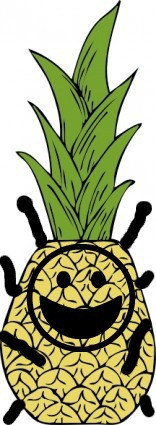Marian Allen's Blog, page 374
January 29, 2014
Bug Bites
The post Bug Bites appeared first on MARIAN ALLEN.
Bug Bites — This is news? I didn’t say “Bugs bite,” though, I said, “Bug bites.” Meaning insects as food.
This may come as a surprise from Little Miss I-Won’t-Eat-That, but I have eaten bugs. To be sure, they were chocolate-covered ants, and chocolate converts almost anything from ick to yum.
Here are some bug bite facts:Insects are an important source of protein in many cultures, and have been since prehistoric times.Termites contain 44 percent fat and 36 percent protein and are said to taste something like pineapple.Some have suggested that stone tools were invented in order to break into termite mounds.The ancient Romans fattened grubs on flour.Locusts, beetles and grasshoppers are specifically mentioned in the Bible as permitted foods. In the New Testament, John the Baptist is said to have eaten locusts and wild honey, apparently a pretty healthy and hearty combination, and not the starvation rations I had always imagined.Seven-year locusts are considered a bountiful delicacy around here.Watch your chickens when bugs are around, though–too much protein causes thin-shelled eggs, even eggs with only membrane and no shell at all.
So remember, if bugs get into your larder or invade your fields, bite ‘em back!
A WRITING PROMPT FOR YOU: A character inadvertently or unwillingly eats a bug. Does he/she ever know it? Is he/she forced to or tricked into it, or is it a bet or a dare or a necessity or an accident or what?
MA
The post Bug Bites appeared first on MARIAN ALLEN.

January 28, 2014
Freddy the Horse
The post Freddy the Horse appeared first on MARIAN ALLEN.
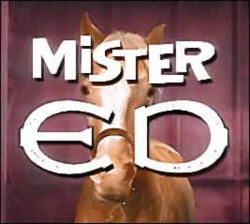 Freddy is NOT a horse, of course; Freddy is a pig. But, in a happy circumstance, I’ve learned that one of my favorite childhood TV shows, Mister Ed, was created by the writer of one of my favorite childhood book series, Freddy the Pig: Walter R. Brooks.
Freddy is NOT a horse, of course; Freddy is a pig. But, in a happy circumstance, I’ve learned that one of my favorite childhood TV shows, Mister Ed, was created by the writer of one of my favorite childhood book series, Freddy the Pig: Walter R. Brooks.
They have this in common: They’re about talking animals.
They have this in difference: Mr. Ed only talked to one person and was the only talking animal on the show; in the Freddy books, all animals (and birds and insects) could talk, and would talk to anybody they wanted to talk to.
I mean, NATURALLY, I adored both these, even though Mister Ed was about dumb grown-ups. All kids know animals could talk if they wanted to, and I haven’t given up hope. I did have a dog once who said, “Hello,” when anybody got out of a car. This was before YouTube and before camera video phones, so I don’t have a clip of it, alas. I miss Rufus, and I miss his sweet Hello.
But I still have Mister Ed and Freddy the Pig.
A WRITING PROMPT FOR YOU: The first animal (or bird or insect) you see can talk: what does it say?
MA
The post Freddy the Horse appeared first on MARIAN ALLEN.

January 27, 2014
Writing In Fits and Starts
The post Writing In Fits and Starts appeared first on MARIAN ALLEN.
 Writing is one of those things that divide people into two types: Those who think it can be taught and those who don’t. Or those who think it should be done by outline and those who think it should be done by the seat of the pants. Or those who think it should be done chronologically and those who think it should be done in scenes and then stitched together like a quilt.
Writing is one of those things that divide people into two types: Those who think it can be taught and those who don’t. Or those who think it should be done by outline and those who think it should be done by the seat of the pants. Or those who think it should be done chronologically and those who think it should be done in scenes and then stitched together like a quilt.
Or those who think there are two kinds of writers and those who don’t.
One thing all storytellers (and storylisteners) agree on, though, is that a story should have a beginning, a middle, and an end. Now, just where those appear, and it what order, can vary. William Faulkner’s “A Rose for Emily” hops all around, and where the story truly begins or ends depends on who’s observing what action.
Here’s a simplified version of writing openings.Let’s say you’ve outlined your plot, and you have a good idea of the characters you’ll need, and you know your main characters so well you can think and speak for each of them and you know the tone you want to take and all that. Where do you begin? Your characters’ whole lives have led up to the climax at the end of the book; at what point do you pick up their trails and follow them to it? Harper Lee acknowledges this question in the beginning of TO KILL A MOCKINGBIRD, when she says:
“I maintain that the Ewells started it all, but Jem, who was four years my senior, said it started long before that. He said it began the summer Dill came to us, when Dill first gave us the idea of making Boo Radley come out.
I said if he wanted to take a broad view of the thing, it really began with Andrew Jackson.”
James Michener solves this problem by beginning at the dawn of time or thereabouts…
Nancy Kress, writing for Writer’s Digest, offers five suggestions for openers:1. Start with the first crisis. C. S. Forester’s THE AFRICAN QUEEN opens with the death of Rose Sayer’s brother and the arrival of Charlie Allnutt. How Rose and her brother came to be in Africa and the contribution the Germans made to the brother’s decline are telescoped, and the chapter focuses on this first crisis in Rose and Charlie’s adventures.
2. Start with the last, major crisis. Remember THEY SHOOT HORSES, DON’T THEY? It begins with a young man shooting a young woman in the head, while dance music plays in the background. The rest of the story is flashback, showing us what brought those two people to that moment.
3. Start well before the crisis, with the circumstances that will create it. This is pretty standard: TO KILL A MOCKINGBIRD really does begin with Andrew Jackson, telescoping the history of the main characters’ family in the region, and the history of the town, then slowing down for the meeting with Dill, the story of Boo Radley, and the beginning of the children’s obsession with seeing him.
4. Start after the crisis is over. THE TIN DRUM by Gunter Grass begins with the narrator in a madhouse; with the narrator’s attempt to explain himself to us and himself by writing the story of his life. The book is that story. Again, most of the book is flashback.
5. Start with a limited dramatic scene. Begin with a scene in which a character attacks a problem that is linked in some way with the later, major problem. LORD OF THE FLIES begins with the protagonists, Piggy and Ralph, stranded on a tropical island; the heat, the rocks, the creepers. Piggy defers to the athletic, good-looking Ralph, although Piggy has all the ideas and Ralph only carries them out. The chapter ends with Jack, who hesitated when he could have killed a pig for the boys’ supper, promising to show no mercy in the future. The seeds of every major turning point in the rest of the book are planted in this first chapter.
It’s a good example of writing the kind of beginning F. A. Rockwell describes:1. It should capture attention with a fresh, original hook.
2. arouse expectation with a promise of more to come.
3. let the reader in on the who, what, when, where, and why, planting subtle clues, if possible, to the resolution.
4. include a cliffhanger that makes us read on.
5. set the tone.
If you’re starting to work on a story and you can’t come up with an opening you think fits the bill, don’t worry about it. Just write any old thing until you get into the story. Write the rough. Find the heart. Write the beginning last, if that’s what it takes. After all, if the start needs to set up everything that comes after — and it does — you have to know what comes after, right?
A WRITING PROMPT FOR YOU: Look up ten powerful stories and study their beginnings and how they set up the rest of the stories.
MA
The post Writing In Fits and Starts appeared first on MARIAN ALLEN.

January 26, 2014
SampleSunday Not Your Typical Fantasy
The post SampleSunday Not Your Typical Fantasy appeared first on MARIAN ALLEN.
I love fantasy, especially if it has unicorns in it, especially if the unicorn is a force to be reckoned with. The one in Peter S. Beagle’s THE LAST UNICORN was tender BUT ALSO tough as nails. So, naturally, when I wrote my SAGE fantasy trilogy, my unicorn couldn’t be a prancy-dancy, rainbow-pooping, flower-and-sugar confection.
Bargain With Fate, Book 1 of SAGE — excerptElsie meets the Unicorn
by Marian Allen
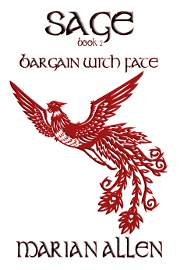 She hadn’t gone far before she knew she was being followed. On the bank behind her, something moved among the trees. She couldn’t see it, but she recognized the feeling and the focus. It was the something that had driven her into the river.
She hadn’t gone far before she knew she was being followed. On the bank behind her, something moved among the trees. She couldn’t see it, but she recognized the feeling and the focus. It was the something that had driven her into the river.
She stopped and faced its coming. “I’ve left the island.” Her voice rang clear in the still air. “Let the old woman alone.”
The stars grew brighter, pierced the darkness, and traced a silhouette.
The thing among the trees was animal – monstrously large, of impossible bulk – unthinkable, that it could move so silently. The lines of its oddly balanced body were forceful and broad. Only such a column as its neck could support such a head, wide and long, of odd proportions in the imperfect light. From the center of its forehead, from between the heavy brows, from a base as broad as Elsie’s hand, thrust a spiral horn.
Unicorn. But when had “unicorn” meant such a beast as this? A plowhorse would seem a colt beside it. Its hooves were the size of dinner plates. It was the color of lead in the dimness. The whole world was the color of lead. Its eyes reflected silver, and the light seemed stronger in the reflection than in its original beams. It was terrible, indeed. And it was beautiful.
The creature’s own presence overwhelmed the Other that it carried. It enveloped the girl. Not masculine, not feminine, not both, not neither, it enfolded her; it included her. It was strength defenseless. It was tender ferocity.
This was no slave of Landry Oliva, nor of his sorceress mother. Arrogance would sink in this presence. Authority would melt. Commands would wash away like marks on wave-lapped sand. Again she felt the rest between her heartbeats filled with the beat of the creature’s heart. She felt its breath in her lungs, richer than normal air.
Book 1 – The Fall of Onagros
Book 2 – Bargain With Fate
Book 3 – Silver and Iron
~*~
What do you think about fantasy? Do you like your heroines unflinchingly fearless, your unicorns fluffy and your dragons either paragons of evil or angst-ridden and misunderstood? If you like it like that, you probably won’t like SAGE.
Follow the “Read about it and sample it” links for longer excerpts than Amazon offers.
A WRITING PROMPT FOR YOU: A character meets a unicorn.
MA
The post SampleSunday Not Your Typical Fantasy appeared first on MARIAN ALLEN.

January 25, 2014
#Caturday Katya and Her Eyes of Doom
The post #Caturday Katya and Her Eyes of Doom appeared first on MARIAN ALLEN.
 Katya Graymalkin here. Happy Caturday!
Katya Graymalkin here. Happy Caturday!
Mom finally brought her new camera phone home and snapped some pictures of me, which is probably the whole reason she got it in the first place.
I decided the best way to break in the camera was by demonstrating my laser stare.
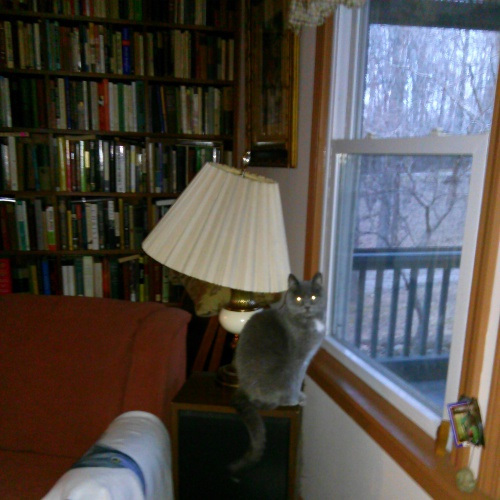
Eyes o’ Doom
..
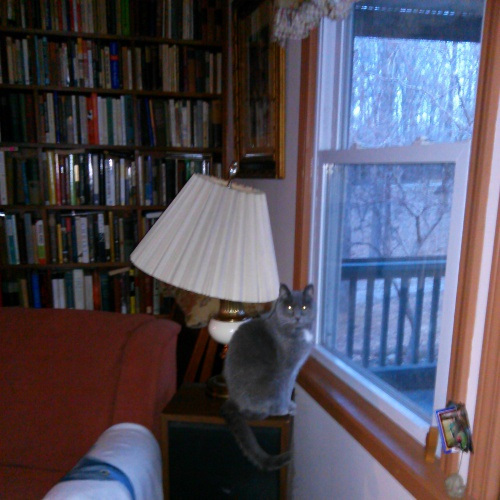
Eyes o’ Doom
Low Beams
..
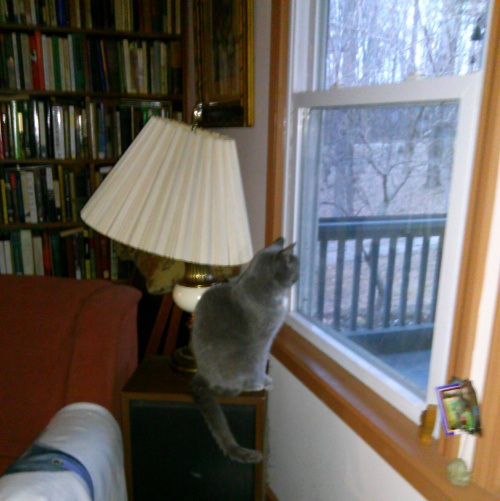
Bored
A WRITING PROMPT FOR ANIMALS: How would you like to pose for your official picture?
KG
The post #Caturday Katya and Her Eyes of Doom appeared first on MARIAN ALLEN.

January 24, 2014
Glorious and Otherwise
The post Glorious and Otherwise appeared first on MARIAN ALLEN.
 My helicopter writer friend, Byron Edgington, author of THE SKY BEHIND ME, pointed me to the wonderful, WONDERFUL artist/illustrator, Natalia Maroz. Here is her website and here is her Shutterstock portfolio. Her art varies from haunting to whimsical. I absolutely LOVE her work.
My helicopter writer friend, Byron Edgington, author of THE SKY BEHIND ME, pointed me to the wonderful, WONDERFUL artist/illustrator, Natalia Maroz. Here is her website and here is her Shutterstock portfolio. Her art varies from haunting to whimsical. I absolutely LOVE her work.
Now here are a bunch of YouTube stuff I’ve been collecting.
First is Asap THOUGHT and Asap SCIENCE. Click through and learn about plant intelligence and video games.
Now, especially if you like to read, go check out Thug Lit to get the down-low on classic literature like “The Picture of Dorian Gray,” yo!
If you don’t know what Sweding is, here is Know Your Meme’s definition. And here is Twin Cities Sweding‘s YouTube channel. You’re welcome.
Finally, although I may have posted this before, Imma post it again because I love it.
A WRITING PROMPT FOR YOU: Have a character give a synopsis of a famous book or story in a way that will be understandable to someone who wouldn’t “get it” by reading it.
MA
The post Glorious and Otherwise appeared first on MARIAN ALLEN.

January 23, 2014
The Happiness Of Home
I’ve been staying with Mom while she’s been feeling under the weather — or whatever it is she’s been feeling under. She just lives next door, so it isn’t as if I’ve left the state or anything.
Charlie comes up to visit a couple of times a day. He or Daughter #1 send me food and Mom has some in the pantry and the freezer (she “eats” liquid nutrition), so there’s plenty to eat. And there’s lots of food at our house, so Charlie has plenty to eat.
Still, he sounded kind of pitiful this afternoon. He’s been making soup, and I think he’s tired of it, even though he makes EXCELLENT veg soup.
 School was out today, so one of our grandsons was visiting and Charlie built a fire in the fireplace to keep him toasty-warm. In pursuit of my policy of not putting pictures of children on the internet, I’m showing him from the back, not his face.
School was out today, so one of our grandsons was visiting and Charlie built a fire in the fireplace to keep him toasty-warm. In pursuit of my policy of not putting pictures of children on the internet, I’m showing him from the back, not his face.
So, after I made sure Mom had her 4:00 goodies, I walked next door to my house and made some supper for us.
I made a salad and some of those cauli-tots I shared a link to one Friday. They were good, but they could have used more salt. But not bad at all.
 I pulled out the stuff for the salad, and Charlie was like, “You have all kinds of stuff hidden in there.” Heee! This is lettuce, yellow sweet peppers, celery, purple cabbage, and sugar-toasted pecans.
I pulled out the stuff for the salad, and Charlie was like, “You have all kinds of stuff hidden in there.” Heee! This is lettuce, yellow sweet peppers, celery, purple cabbage, and sugar-toasted pecans.
And you know what felt best and homiest? USING MY OWN KNIVES! My friend Jane gave me a set of chef’s knives (Emeril) and I keep ‘em good and sharp. There’s nothing sweeter than the way they chop and slice exactly the way I want them to. I know that sounds creepy; I would have said that, too, before I got those good knives.
So THANK YOU AGAIN, Jane! 
A WRITING PROMPT FOR YOU: A character is away from home and misses something he or she would not have expected to miss, particularly.
MA

January 22, 2014
Horse Chestnuts
It just goes to show, you’re never too old to learn.
I just found out a couple of days ago what conkers are. In case you’ve never heard of conkers, people in books set in England will sometimes talk about conkers or playing conkers. I never knew what that was, and it was never germane to the plot, so I just took the general meaning that conkers were a fruit or nut from a tree that kids picked up and played with in some manner.
Then, the other day, I stumbled across the wonderful Liam O’Farrell’s painting of conkers.
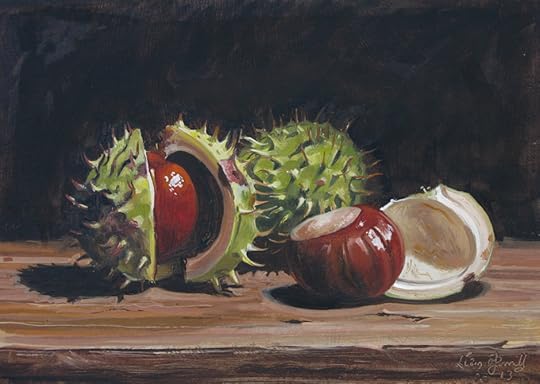
Liam O’Farrell’s painting of conkers
Isn’t that gorgeous?
And I was like: THEY’RE BUCKEYES!!
Buckeyes are what we call them in the USA. It’s the translation of an Indian name, because they thought the nut looked like the eye of a male deer. Ohio is nicknamed “the Buckeye State” mostly because of all the horse chestnut trees it used to have.
And once more, you’re welcome.
A WRITING PROMPT FOR YOU: A character makes something edible that looks like something inedible.
MA

January 21, 2014
Gizmo Geekery
 Okay, so I got that new smart phone, and I’ve been having a blast with it. I only have one contact phone number in it — my house phone — which is a good thing, because I hit it by mistake today.
Okay, so I got that new smart phone, and I’ve been having a blast with it. I only have one contact phone number in it — my house phone — which is a good thing, because I hit it by mistake today.
This is what my phone looks like. I think it’s bee-you-ti-ful! I got it on the cheap (relatively speaking), so it didn’t come with a manual, but I know a trick worth two of that one, and I Googled it and downloaded a manual ha ha.
 So THEN I had to go download a QR code reader, right? So I could click on those little squiggly squares you see EV-RY-WHERE?
So THEN I had to go download a QR code reader, right? So I could click on those little squiggly squares you see EV-RY-WHERE?
So I got one.
 Then I went to Square, Inc. and ordered a credit card reader — A FREE ONE, my favorite price point for other people’s merchandise.
Then I went to Square, Inc. and ordered a credit card reader — A FREE ONE, my favorite price point for other people’s merchandise.
Finally, I went to the bank and opened a new bank account. It is into that account that I’ll deposit whatever I sell through the credit card reader. And, yes, I took the opportunity while I was opening the account to tell the tellers about my books and left them copies of my card.
Ready for my truckload of money, Mr. DeMille!
A WRITING PROMPT FOR YOU: A character has to go through many more steps than he or she considers tolerable in order to perform a simple act.
MA

January 20, 2014
Thoughts On Fanfic
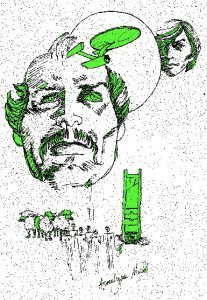
Hizzoner Mudd
illustration copyright
C. Jane Peyton
This post appeared in a slightly modified form on my old WEBLAHG.
Several people told me that it was unprofessional to have personal stuff on a pro site, so I put the personal stuff and the free stuff on the WEBLAHG.
Also, here is a post I did for the Virtual Writers’ Conference in 2009. My post was called:
FANFIC–What is it, why is it, what good is it?For those who don’t know, fanfic (or fan-fic) is short for fan fiction–fiction, usually unauthorized, based on already-existing creations written by fans of those creations. Fan fiction isn’t intended to be a rip-off, although there are some creators and copyright holders who consider it to be. The purpose of fan fiction is to explore various possibilities of a fictional reality.
Fan fiction can be very close to the original; it could pass for an unpublished part of the canon or an unscreened episode of the series. It can be a little afield of the original, establishing the fan’s version of a backstory, or featuring a minor supporting character from a book or show. It can be father afield that that, and just take place in the fictional world created by the originator: a story about students at Star Fleet Academy with no mention of the Star Trek characters, or the adventures of a wizard in the Harry Potter universe with no connection to the Harry Potter characters.
There’s a whole range of stories called “slash”, which aren’t… necessarily… violent–they’re intimate-relationship stories, like a romance between , say, Sherlock Holmes and Irene Adler. That would be Holmes/Adler, and not too strange. Holmes/Watson, on the other hand, would go right out of the park, and I’m sure there have been many written. Please don’t tell me. Please. Really.Then there are cross-overs, which are blends of two or more fictional worlds, like the characters in Twilight taking a vacation in Collinsport and meeting the characters of Dark Shadows. Okay, now I’m snorting type 0 out of my nose….
Finally, there’s the kind of fanfic that Star Trek fans call “Mary Sue”. That’s when you insert a character who is a fantasy version of yourself into a fictional world. She (it’s sometimes a he, but the stereotypical fanfic writer of this kind of story is female) interacts with the standard characters, is usually fascinating or brilliant or hilariously sarcastic or gorgeous or slapstick-clumsy or otherwise larger than life, and ends up saving everyone from something or other.
I’ve written a goodly amount of fan fiction, myself. It can seem like a long time between episodes or sequels or stories by the author, and fan IS short for fanatic, you know. I’ve even written Mary Sue. It’s fun. In fact, it’s more than fun, if you really try to recreate the world you’re exploring. It’s like riding a bike with training wheels. It’s like learning how to paint by learning how to copy other people’s paintings, which is a standard exercise for artists. If you’re crazy about a show or a book or a movie, so crazy you can’t get enough of it, copying it as nearly as you can is one way to take it apart and find out what’s so appealing about it. Writing scenes and dialog for established characters is good practice for everything from pacing to character continuity to each-person-has-a-unique-voice. You can share your results with other fans–and take bigger lumps than an original creator, if you’ve done a bad job–but you can’t market your work. You have creative pressure, but no financial pressure. It’s for the love, the way all good writing is, whether you get paid for it or not.
I’ve heard a fellow professional writer attack fanfic writers as being somehow pathetic. “Why don’t you create your own things, instead of stealing somebody else’s work?” I had to disagree with him. Fanfic isn’t taking anything away from the originators. People who come across a good piece of fan fiction will almost always want to go to the original. Fanfic writers are creating their own stories; they’re just using copyrighted raw materials, rather than, say, folk tales. And it’s a small step across that line between expanding on someone else’s imaginings and beginning to trust totally in your own imagination.
Go on, Grasshopper. Make it so.
A WRITING PROMPT FOR YOU: Take a show you really like, or a book or a movie. Are there any loose ends you would like tied up? Stories you’d like pursued? Changes you would make to the plotline?
MA


